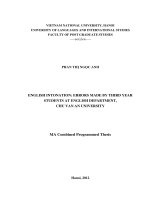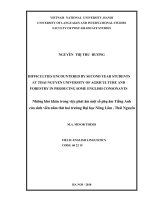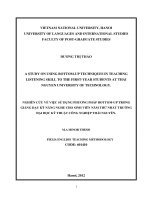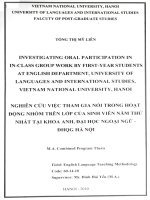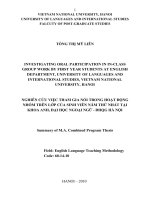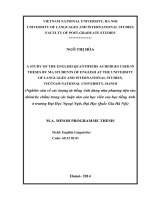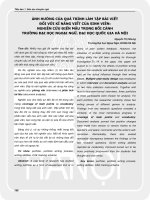INVESTIGATING ORAL PARTICIPATION IN IN-CLASS GROUP WORK BY FIRST YEAR STUDENTS AT ENGLISH DEPARTMENT, UNIVERSITY OF LANGUAGES AND INTERNATIONAL STUDIES, VIETNAM NATIONAL UNIVERSITY, HANOI
Bạn đang xem bản rút gọn của tài liệu. Xem và tải ngay bản đầy đủ của tài liệu tại đây (59.88 MB, 108 trang )
VIETNAM NATIONAL UNIVERSITY, HANOI
UNIVERSITY OF LANGUAGES AND INTERNATIONAL STUDIES
FALCUTY OF POST-GRADUATE STUDIES
TONG
THI
MY LIEN
INVESTIGATING ORAL PARTICIPATION IN
IN-CLASS GROUP WORK BY FIRST-YEAR STUDENTS
AT ENGLISH DEPARTMENT, UNIVERSITY OF
LANGUAGES AND INTERNATIONAL STUDIES,
VIETNAM NATIONAL UNIVERSITY, HANOI
NGHIEN CUU
VIEC
THAM
GIA NOI
TRONG HOAT
DONG NHOM TREN LOP CUA
SINH VIEN
NAM
THU
NHAT
TAI
KHOA ANH, DAI HOC
NGOAI NGU
-
DHQG
HA
NOI
M.A. Combined Program Thesis
Field: English Language Teaching Methodology
Code:
60-14-10
Supervisor: Ms. Dinh Hai Yen (M.A.)
HANOI-2010
IV
TABLE OF CONTENTS
Page
Retention
j
Acknowledgements ii
Abstract iii
Table of contents iv
List of abbreviations vii
List of tables viii
List of figures ix
INTRODUCTION
1.
Problem statement and rationale 1
2.
Aims of the study 2
3.
Scope of the study 3
4.
Significance of the study 3
5.
Organization of the study 4
DEVELOPMENT
CHAPTER 1: LITERATURE REVIEW
1.1 Definitions of key terms 5
/./. / Group work
-5
1.1.2
Participation
6
1.2 Overview of group work
7
1.2.1
Group organization
7
L2.2
Benefits of group work
8
1.2.3 Problems oj group work
9
1.3 ESL/ EFL students' participation in group work
11
1.3.1
The importance ofESL/EFL students 'participation in group
work //
1.3.2 Patterns of students 'participation in group work //
1.3.3 Students
'
lack of participation in group work 12
1.4 Influential factors on ESL/EFL
students'
participation in in-class group work 13
1.4.1
Student-related factors
14
1.4.2 Pedagogy-related factors
15
1.4.3 Culture-related factors
16
1.5 Teachers' monitoring strategies to increase students" participation in group
work
17
1.6 Justification for the research 18
CHAPTER 2: RESEARCH METHODS
2.1 Participants 20
2.2 Data collection methods 20
2.2.7
Questionnaires
21
2.2.2 Semi-structured
intervicM's
22
2.2.3 Observations 23
2.3 Data collection procedures 23
2.4 Data analysis methods and procedures 25
CHAPTER 3: FINDINGS AND DISCUSSION
3.1
Students'
perceptions towards group work 26
3.2
Students'
participation in in-class group work 32
3.3 Factors affecting
students"
participation m
in-class
group work 43
3.4 Teachers' monitoring strategies during group work 60
VI
CONCLUSION
1.
Summary of the study 68
2.
Pedagogical implications 69
3.
Limitations of the study 73
4.
Suggestions for further studies 73
REFERENCES
APPENDICES
VII
LIST OF ABBREVIATIONS
ED:
English Department
EFL; English as a Foreign Language
ELT: English Language Teaching
ESL:
English as a Second language
ULIS:
University of Languages and International Studies
NNS:
Non-native English Speaker
NNSs: Non-native English Speakers
NS:
Native English Speaker
NSs:
Native English Speakers
VNU: Vietnam National University
Vlll
LIST OF TABLES
Table 3.1: Students' perceptions towards group work
Table 3.2: Students' participation in in-class group work
Table 3.3: Student-related factors
Table 3.4: Pedagogy-related factors
Table 3.5: Culture-related factors
Table 3.6: Teachers' monitoring strategies during group work - Teacher application
Table 3.7: Teachers' monitoring strategies during group work - Student preference
Table 3.8: Teachers' observed monitoring strategies during group work
IX
LIST OF FIGURES
Figure
3,1:
Students' perceptions of group work's advantages
Figure 3.2: Students' perceptions of group work's disadvantages
Figure 3.3: Participation patterns in in-class group work
Figure 3.4: Quality of ideas shared in in-class group work
Figure 3.5: Participation imbalance in in-class group work
Figure 3.6: Number of turns taken by different group members
Figure 3.7: Amount of talking time of different group members
Figure 3.8: Student-related factors
Figure 3.9: Pedagogy-related factors
Figure
3,10:
Culture-related factors
INTRODUCTION
1.
PROBLEM STATEMENT AND RATIONALE
Group work has been widely believed to offer various advantages such as enhancing
students' interaction, generating a supportive atmosphere, creating chances to use the
target language and promoting learner autonomy (Long & Porter, 1985: Brown, 2001).
Thus,
it has blossomed in English as a Second Language (ESL) and English as a Foreign
Language (EFL) classrooms. The emphasis on group activities is particularly noteworthy
in Vietnamese English Language Teaching (ELT) setting where students are EFL learners
and have few opportunities to use English in daily life (Vo, 2004). Nonetheless, the
effectiveness of group work has been reconsidered closely since Tickoo
(1991,
p.53)
left
the open question
"/.v
group work a pedagogic universal or a partial
remedy'^"
after his
experiment comparing the success of
a
group-work class with a
teacher-directed
one.
Since
then, the need to examine how group-work theory works in practice has rapidly emerged.
Addressing this issue, in the world of language teaching, various studies such as those by
Jones
(1995),
Zhenhui (2001), Martine (2003), Yuenfeng (2005), and Chen (2004) were
conducted to discover what actually happened when implementing group activities in
language classrooms. However, deep empirical investigations in the sub-area of students'
participation and influential factors on their participation in group work were few in
number
-
Martine (2003) and Yuenfeng (2005). Pitifully, those merely explored learners'
oral participation level measured by the number of turns taken and the amount of talking
time.
Thus, a more comprehensive evaluation of their participation would be highly
appreciated in the research field.
In addition, although Martine (2003) discovered many possible influential elements, it was
targeted at mixed-culture groups of native-English-speaker (NS) and non-native-English-
speaker (NNS) postgraduate students, rather than single-culture groups of
tertiar>
EFL
learners,
in the meantime, Yuenfeng (2005) examined
tertian.
EFL learners in single-
culture groups, but it only focused on two factors, namely task t>pes and teacher roles.
Furthermore, all of the related studies (Martine,
2003;
Yuenfeng, 2005; Melles, 2004;
Jones,
1995) simply based on the qualitative methods. Accordingly, in those investigations,
there might be inevitably potential limitations of relying on a single approach (Nunan,
1992).
With regard to Vietnam's ELT context, the aforementioned issue has not been thoroughly
investigated despite the existence of a few related studies such as the one by Vo (2004).
This means thorough exploration into EFL students' oral participation and influential
factors in single-culture group work remain a gap.
The urgency to do research into the discussed matter becomes significant, when it comes to
the ELT context of University of Languages and International Studies, Vietnam National
University (ULIS, VNU). Although group work is a familiar ELT method at English
Department (ED), it is considerably new for the majority of freshmen, who have had little
previous group-learning experience in high school. Consequently, it has inevitably posed
huge challenges for both teachers and students at this site.
The study entitled
'"investigating
oral participation in in-class group work by first-year
EFL students at
ED,
VLISy
VNlf^
was conducted as an attempt to examine the
perceptions of first-year EFL learners at
ULIS,
VNU towards group work, investigate their
participation level and quality in group work, find out possible influential factors on their
participation, and pinpoint teachers' monitoring strategies to motivate students to
participate in group activities.
HopefulK,
this
research,
focusing on single-culture groups
of Vietnamese EFL students at tertiary level, could narrow the abovementioned research
gaps and bring new perspectives to the field.
2.
AIMS OF
THE STUDY
The purpose of this study was to
investigate
the oral participation of first-year EFL
students at ULIS, VNU in in-class group work. Specifically, it addressed the following
research questions:
/. What do first-year EFL students at ULIS, VNU think about group work?
2.
How are those students ' level and quality of oral participation in in-class group work?
3.
What factors affect those students ' oral participation in in-class group work?
4. Which monitoring strategies have EFL teachers at the research site applied to increase
the
students*
oral participation in in-class group
work'^
Which ones are preferred by
the students?
From the findings, the researcher would recommend several pedagogical implications to
motivate and balance the oral participation of first-year EFL students at
ULIS,
VNU in
group work, eliminate negative influential factors on their participation, and boost positive
ones.
3.
SCOPE OF THE STUDY
Due to time constraints, instead of aiming at group activities in general, the study focused
on those conducted within classroom contexts. Besides, the study merely examined the oral
participation of EFL students rather than both verbal and non-verbal aspects. Moreover, it
was carried out with just a sample of 100 first-year EFL students and five teachers of
English at ED at ULIS, VNU.
4.
SIGNIFICANCE OF THE STUDY
Although the study was conducted on a small scale with a particular group of first-year
EFL students at ULIS, VNU, the researcher hoped that its findings could be of great
significance. Specifically, it would contribute to the existing knowledge in the field
concerning group work, students' participation in group work,
infiuential
factors on their
participation, and teachers' strategies to motivate students to participate.
Moreover,
it
could help to raise awareness of first-year EFL
students
at ULIS, as well as EFL learners.
about the problems in the participation of their peers in in-class group work and certain
elements affecting their participation. It could also assist teachers of English to recognize
what encourage or discourage a number of their students from participating in group
activities so that
the\
could adjust their teaching methods to motivate their students in
language learning. Finally, it would propose several
useftil
recommendations for teachers
to minimize negative impacts of infiuential factors on
students'
participation in group
work.
5.
ORGANIZATION OF THE STUDY
The research report consists of three parts. The Introduction presents the rationale, aims,
scope, and significance of the study. The Development includes three chapters. Chapter
One covers an in-depth review of the literature in which relevant theoretical background
and reviews of related studies concerning group work, ESL/EFL
students'
participation in
group work, infiuential factors, and teachers' monitoring strategies are discussed. Chapter
Two continues with the research methods including the participants of the study, the
methods and procedures of data collection and data analysis. Chapter Three demonstrates
the findings accompanied by data analysis and interpretation. The Conclusion ends the
report with the summary of the findings, pedagogical
implications,
limitations of the study
and suggestions for further studies.
DEVELOPMENT
CHAPTER 1: LITERATURE REVIEW
This chapter gives an overview of the literature related to the present study. In the chapter,
definitions of key terms {group work and participation) and selected theoretical
background such as group organization, benefits, and problems of group work are
presented. Then the review of the areas relevant to the research questions, namely
ESL/EFL students' participation, influential factors on their participation, and teachers'
monitoring strategies to encourage them to participate in in-class group
work,
is also
provided.
1.1 DEFINITIONS OF KEY TERMS
1.1.1 GROUP WORK
There is a general consensus among educators about the definition of group work. For
example, group work is
"a
generic term covering a multiplicity of techniques in which two
or more students are assigned a task that involves collaboration and self-initiated language"
(Brown, 2001,
p.177).
Doff
(1998)
gives a simpler explanation:
Group work is a process that the teacher divides the class into small groups to work
together (usually four or
five
students in each group) and all the groups work at the same
lime(p.l38).
Vo (2004) also follows Doffs approach as she defines group work as "any classroom
activity in which students perform collaborative tasks with one or more partners" (p. 16).
On the whole, it is widely agreed that group work is a process in which two or more
learners work together to do a task which involves cooperation and self-generated
language.
Although applying group work in classroom contexts has been extensively discussed in the
literature, not much has been said about the classification of group activities. Johnson and
Smith (1991) are among the few researchers who have touched upon this matter
systematically. According to them, basically, there are three main kinds of group work:
informal learning groups, formal learning groups, and study teams. First, informal learning
groups are a form of grouping students temporarily within a single class session. A class of
any size can be organized into informal groups at any time of the lesson to check students'
understanding of the material, or to provide them with chances to apply what they are
learning (Johnson and Smith, 1991). For instance, teachers may ask those sitting near each
other to work in teams and spend five minutes discussing a topic.
Second,/orma/
learning
groups are groups which are formed to do a specific task such as delivering a presentation,
or conducting a project (Johnson and Smith, 1991). In these
groups,
students work together
in one class session or even for several weeks until they have finished their task, and
teachers will grade their work. Finally, study teams are long-term groups with stable
members which usually exist during a semester. The objectives of these teams are to
encourage and support their members in meeting course requirements and doing
assignments or to inform those who have missed a lesson about lectures and assignments
(Johnson and Smith, 1991). Due to the small scale of this study, only the type of informal
learning groups within a single class session is discussed.
In general, in this research the term
'"group
work"
refers to oral activities done in small
groups inside the classroom, normally in the form of group discussions.
1.1.2 PARTICIPATION
So far, research has focused greatly on students' participation in classroom discussions.
concerning both verbal and non-verbal participation (Lee, 2005; Liu, 2001). Verbal
participation means speaking in class, answering and asking
questions,
giving comments,
and taking part in discussions (Lee, 2005). Those who do not participate in the
aforementioned ways are often regarded as passive learners, and are penalized when
participation is graded. On the
contrar\,
non-verbal participation refers to behavioral
responses during the lesson such as head nodding, hand raising, body gestures, and eye
contact (Lee, 2005).
Similarly, students' participation in group activities can be assessed in terms of verbal and
non-verbal participation as well. Nonetheless, evaluating non-verbal participation will take
much time; therefore, due to time constraints, the scope of this study was merely restricted
to investigating students' verbal participation.
Besides, when investigating oral participation, researchers have just paid attention to the
observable aspects of participation such as the number of turns taken or the amount of
talking time (Martine, 2003). However, the researcher of the present study supposed that
the quality of ideas students give out during the activities should be also judged so that a
more comprehensive evaluation of students' participation can be made.
To sum up, this study examined students' oral participation, measured by their number of
turns taken, their amount of talking time, and the quality of their ideas shared during group
work to create a more comprehensive investigation.
1.2 OVERVIEW OF GROUP WORK
1.2.1 GROUP ORGANIZATION
When deciding to use this kind of activity, teachers have to think of group organization.
involving two factors: how big a group should be (group size), and how students can be
allocated to groups (group formation).
There are several arguments about group size. According to Honeyfield
(1991),
a team can
contain between five and eight students. Meanwhile, Brown (2001) argues that the number
of between two and six learners is appropriate. In fact, the size of a group depends on
certain elements such as the number of students in the class, the task itself and the duration
of the activity (Zhenhui, 2001; Chen, 2004). Nevertheless, small groups of four or five
appear to be the most effective.
It
is likely to create more interesting and challenging tasks
with a variety of opinions shared, and adequate negotiation among members to reach
agreement (Honeyfield, 1991). Harmer (2001) also stresses
students'
great involvement
and participation that can be generated in such small-group work.
8
In terms of group formation, a review of the literature shows that teams can be created by
three major ways, namely random grouping, student-selected grouping and instructor-
formed grouping. First, random grouping is the way to divide learners into groups by
chance (Chen, 2004; Honeyfield, 1991). Depending on the availability of time and kinds of
tasks,
teachers may either group those sitting near each other or use games or competitions
to form teams. Chen (2004) claims that random grouping is by far the most commonly
used in in-class activities for its convenience and readiness. Second, student-selected
grouping or free grouping is the most preferred by students (Chen. 2004; Honeyfield,
1991).
By this way, they have the right to choose their own members. Due to its basis on
friendship, it tends to encourage them to take part in the activities actively (David, 1993, as
cited in Chen, 2004). Finally, groups might be formed by
teachers'
own decisions
concerning several factors (Chen, 2004). For example, Honeyfield (1991) suggests that
they can base on
learners'
proficiency level to divide teams, specifically same proficiency
level grouping and mixed proficiency level grouping.
AdditionalK.
they might take
students' prior achievements, level of preparation, working habits, or learning preferences
into consideration (Chen, 2004).
In a nutshell, the given discussion on group organization indicates that as there are many
available options to choose from, when deciding on group size and group formation.
teachers have to consider many elements like class size, the duration of the activity,
classroom conditions, or
students'
characteristics.
1.2.2 BENEFITS OF GROUP WORK
There is general agreement among scholars that group work brings a variety of advantages,
including enhancing students' interaction, generating a supportive
atmosphere,
creating
chances to use the target language and promoting learner autonomy.
In the first place, group work contributes to the enhancement of students' interaction (Long
& Porter, 1985). As it offers them more chances to interact with each
other,
greater
involvement and accountability can be produced within a group. Thanks to
this,
their
communicative competence, cognitive learning, mteractive skills and interpersonal
relationships tend to be promoted (Zhenhui, 2001).
Secondly, a cooperative affective classroom atmosphere is likely to be created through
group activities (Zhenhui, 2001; Brown, 2001). According to Gower (1987, as cited in
Yuenfeng, 2005), since the pressure of being listened to by the teacher tends to blur when
working in teams, learners feel more relaxed and more ready to speak. Cooperation and
unity among them can be also facilitated (Zhenhui, 2001;
Luft,
1984, as cited in Martine,
2003).
Another benefit is generating a better environment for students to use the target language
(Chen, 2004). Learning in groups, students, especially the poorly motivated ones, have
greater opportunities for active, meaningful and varied use of the target language (Long,
1977,
as cited in Zhenhui, 2001; Chen, 2004). Such an ideal interactive environment is
essential to communicative language learning.
Furthermore, group activities can promote learner autonomy (Brown, 2001; Boumer et
al.,
2001,
as cited in Yuenfeng, 2005). Because students can make their own decisions without
being told what to do by the teacher, they are likely to be more responsible for their
learning (Harmer, 2001).
Overall, group work is commonly supposed to bring four main advantages such as
enhancing students' interaction, generating a supportive atmosphere, creating chances to
use the target language and promoting learner autonomy. However, many researchers still
question whether those benefits of group work really take place in the real educational
setting. They have shown that group work displays certain
problems,
which will be
elaborated in the next section 1.2.3.
1.2.3 PROBLEMS OF GROUP WORK
There is a fair amount of literature on problems of group work. Within the scope of this
research, the most common problems in class, namely intolerable
noises,
overuse of
mother tongue, exposure to imperfect language, and unbalanced participation among group
members, will be reviewed as follows.
First, group work in class inevitably results in a noisy and chaotic classroom. Right from
the beginning of
a
group activity, the organization stage involving grouping students might
10
cause extensive noises (Harmer, 2001). Moreover, Ngoh (1991) adds that noises can be
easily generated from students'
conftasion
when not understanding the instructions for the
assigned task at the instruction stage. Even worse, as Chen (2004) claims, once learners are
unclear about what they are going to do, they may then fall into mutual arguments or
irrelevant chatting conversations.
Moreover, students, especially elementary or even intermediate ones, tend to rely much on
their native language rather than using the target language (Chen, 2004; Yuenfeng, 2005).
This is exactly the distinctive feature of a monolingual class where all share a common
mother tongue (Ngoh, 1991; Brown, 2001). As Ngoh (1991) indicates, when engaged in
group interaction, those of low linguistic competence often resort to their native language;
teacher insistence on using English to communicate might lead to their complete silence.
In addition, learners are prone to expose themselves to imperfect language. Ngoh (1991)
raises the question whether they are really learning from each other in the fear that
inaccurate production may allow the fossilization of inaccurate structures. As Prabhu
(1987,
as cited in Tickoo. 1991) further explains, working in
groups,
students have to
depend on other members for linguistic data while few are known to possess error-free
language. Thus, interaction between members in teams
certainK
causes the great risk of
fossilization; in other words, common errors will gradually take firm roots in their
individual linguistic systems (Prabhu, 1987, as cited in Tickoo. 1991). This is even more
dangerous as the teacher has little chance to make corrections and.
accordingK.
students
will simply reinforce each
other's
errors (Brown, 2001).
Finally, group activities cause unbalanced participation among members (Chen. 2004).
This may be because some may fall into roles that easily become fossilized;
consequentK.
they turn out to be passive whereas the others might dominate (Harmer. 2001). The lack of
participation of some members in groups and many others factors inhibiting students to
participate will be further elaborated in the sections
1.3
and
1.4.
In summary, it is widely agreed that group work might generate many problems such as
intolerable noises, overuse of mother tongue, exposure to imperfect language, and
unbalanced participation among members.
11
1.3
ESL/EFL
STUDENTS' PARTICIPATION IN GROUP WORK
L3.1
THE IMPORTANCE OF ESL/ EFL STUDENTS' PARTICIPATION IN
GROUP WORK
In ESL/ EFL settings, participation in classroom activities is evidently important for
efficient learning to occur since participating actively brings students opportunities to use
and practice their linguistic and communicative skills (Gomez, 1995). Furthermore,
research has shown that students who participate enthusiastically tend to have better
academic achievement in comparison with those who do not participate. For example,
Swain (1993) claims that when producing the language they are studying, students can
gradually boost their linguistic fluency.
As regards working in groups, without their active participation, learners might not gain
any benefits of group work (see
1.2.2).
In that case, applying group activities in classroom
contexts will become a waste of time and effort.
Therefore,
students'
participation is
indispensable in this kind of activity.
It
is part of the learning process, which generates
interaction and initiates the use of the target language among them (Mclnnis, 2006).
Dynamic participation by all members is one of the qualities of an effective group activity.
Nevertheless, as Mclnnis (2006) pitifully states, a large number of students are not actually
aware of the role of participation in group work.
The\
might not understand what
advantages group activities can bring to them. This leads to their hesitance to contribute,
which will be discussed in section
1.3.3.
1,3.2 PATTERNS OF
STUDENTS^
PARTICIPATION IN GROUP WORK
As mentioned earlier, research has concentrated much on students' participation in the
classroom. Liu (2001) is one example. In his research, he even points out four classroom
participation patterns, namely total
mtegration.
conditional
participation,
marginal
interaction, and silent observation.
12
Firstly, total integration refers to students who actively participate in classroom
discussions, knowing exactly when to speak up and what to say (Liu, 2001). Visibly, they
display spontaneous, appropriate, and natural participation.
Secondly, conditional participation is constrained by a range of elements such as socio-
cultural, cognitive, affective, linguistic or environmental ones (Liu, 2001). Due to those
factors, learners' participation and interaction with others and the teacher are often limited.
Furthermore, during the discussions, they are still confused in finding out when to speak,
what to say, and which behavior to display.
Marginal interaction is characterized by students who are attentive listeners but rarely
speak up (Liu, 2001). Instead of participating actively, they opt for listening or note-taking.
Still, when attempting to speak up at times, they are often confident since it is the outcome
of careful thinking and internal rehearsal.
In
the final pattern - silent observation, students tend to withdraw from oral classroom
participation (Liu,
2001).
They appear to accept whatever is discussed and say nothing to
respond to their peers.
However, Liu (2001) emphasizes that students do not follow a fixed pattern of
participation at all times. Instead, their behaviors may differ in different class sessions,
depending on their perceptions which are infiuenced by complex factors.
In
conclusion, there are four participation patterns in the classroom: total integration,
conditional participation, marginal interaction, and silent observation. Certainly, those
patterns can be applied to the case of group activities. When students work in
teams,
they
may also behave in the abovementioned ways.
1.3.3 STUDENTS' LACK OF PARTICIPATION IN
(JROUP
WORK
Several studies such as Ngoh (1991), Tickoo
(1991),
Martine (2003) and Yuenfeng (2005)
have demonstrated that working in groups might not be as effective as expected due to
students'
lack of participation.
13
Learners' lack of participation visibly happens in group activities. For instance, in James
and Devlin's study
(2001,
as cited in Melles, 2004), a large number of ESL learners
confessed that they found it hard to participate in group work. Ngoh (1991) states that this
easily occurs at the process stage, where they are involved in oral interaction, or the
presentation stage. In fact, it is difficult to get everybody involved actively (Yuenfeng,
2005).
It may be because some may fall into roles that easily become fossilized;
consequently, they turn out to be passive whereas the others might dominate (Harmer,
2001).
Moreover, there are numerous factors lying behind learners' lack of participation in
group activities, which will be ftirther discussed in the next section 2.4.
This lack of participation of several members apparently results in unbalanced
participation (Chen, 2004). As Tickoo
(1991,
p.46)
illustrates,
"very
often one or two
group members not only steal turns and grab opportunities but
ver>
often do almost all the
talking. The rest may not even be allowed words in
edgeways."
Evidently, an empirical
study on 14 Non-Native English Speakers (NNSs) and four Native English Speakers (NSs)
in two MA teacher-training courses at the University of Birmingham revealed a high level
of dominance of NS learners over NNS ones when discussing in groups (Martine, 2003).
This is obvious because NNS students' language proficiency is known to be much lower
than NS ones. However, it is also the case of groups of EFL learners as identified in the
comprehensive study on Chinese first-year students by Yuenfeng (2005). Thus, it can be
concluded that the imbalance in students' participation is likely to occur in any classroom
contexts.
In general, to date, previous studies have indicated a serious lack of participation of
ESL/EFL learners in group work, which leads to an imbalance of participation among
members of a team. The factors lying behind this will be discussed in the next section
1.4.
1.4
INFLUENTIAL FACTORS ON ESL/EFL STUDENTS'
PARTICIPATION IN IN-CLASS GROUP WORK
So far, a number of studies have elaborated various elements either encouraging or
inhibiting ESL/ EFL students from participating in in-class group work. Those can be
grouped into three categories, namely student-related, pedagogy-related, and culture-
related factors.
1.4.1 STUDENT-RELATED FACTORS
Claims about ESL/EFL students' lack of participation in group work largely focus on
elements associated with students themselves. The first significant factor is language
difficulties (Baker & Panko, 1998, as cited in Melles, 2004). As a study on groups of NNS
and NS learners in a teacher-training context by Martine (2003) revealed, some
participants in small-group discussions showed their anxiety about their language
proficiency. Owing to their poor vocabulary and grammar, they found it hard to express
their ideas; consequently, they stayed silent for most of the time.
Secondly, background or subject knowledge is of vital importance (Chong,
1999;
Yuenfeng, 2005). As Martine (2003) clarifies, some avoid participating because they do
not know much about the discussed topic, and therefore, have few ideas to share. He also
supposes that sometimes, their lack of confidence as being less knowledgeable than the
others can explain for their non-participation.
Martine (2003) also figures out
students'
difficulties with some aspects of discourse as an
influential element.
In
his study, many Asian learners expressed their unfamiliarity with
turn taking and uncertainty about the applications of turn taking when working with others.
Specifically, they did not know when and how to take turns.
Besides, acceptance of group work might influence student participation.
In
Martines
project (2003), some participants claimed that their positive attitudes toward group work
stimulated them to raise their voice during group discussions with NSs. Meanwhile.
according to Ngoh
(1991),
the inability to perceive the value of group work is detrimental
to students' contributions. Those who believe that group work brings no benefits might
withdraw from the activity, sharing no ideas and giving no responses.
Another element is
students'
previous experience with group work. The lack of
exposure lo
group work of the majority of NNS learners was a great hmdrance in group participation
(Marline, 2003). Despite their desire to participate, it was difficult for them to do so since
15
they were not familiar with working in groups, lacking group work or communication
skills to negotiate with others.
Lastly, students' personalities might determine their participation level in group work (Vo,
2004).
Yuenfeng (2005) exemplifies that some might be too shy to contribute; as a result,
they stay silent during the activity.
1.4.2
PEDAGOGY-RELATED
FACTORS
Pedagogy-related factors refer to the impact of the task, the teacher, and peers on students
during group work.
Firstly, the level of difficulty of the task and the level of interest of the topic can affect
students'
participation. As shown in the classroom research on a group of Vietnamese
secondary learners by Vo (2004), several participants said nothing when they found
the
topic uninteresting or difficult.
Secondly, teacher role plays a part in learners' participation ratio.
Vo's
(2004) indicates
that many students are not motivated to join the group activity if the teacher does not set up
clear rules for group-work participation. Moreover, an experimental
stud\'
with 30 first-
year EFL Chinese students found that the teacher's clear instructions and his absence
during group interaction encouraged students to speak more and created a more balanced
performance (Yuenfeng, 2005).
Finally, learners are being seriously influenced by peers. According to Ohata (2005),
despite their initial intention to participate, students might feel anxious for fear of negative
evaluation from their peers. Meanwhile, Vo (2004)
emphasized
the influence of common
interests by pointing out students' discomfort and boredom when working with those
the\
dislike. In other words, the satisfaction level of participation partly depends on group
members' willingness to cooperate. In addition, Martine (2003) states that the lack of
participation of peers has an antagonistic effect on those who participate more, i.e. their
compulsion to talk more than they like due to the lack of input from others.
16
1.4.3 CULTURE-RELATED FACTORS
The lack of participation in group work might be the matter of cultural influences as
well
(Ngoh,
1991).
A relatively large body of research has reached consensus on the role of
culture in ESL/EFL learner participation in groups due to its effects on their approaches to
group work (Andrews & Dekkers, 1999; Anyanwu, 2000, as cited in Melles, 2004). Chan
(1999,
as cited in Melles, 2004) even says that NNS students' lack of participation is
sometimes assumed to be a cultural disposition. Among the researchers, Martine (2003)
goes deep into this issue by giving further clarification about cultural impact, which is
strongly supported by Yuenfeng (2005).
First, cultural factor refers to theories on uncertainty avoidance including the concept of
face and the fear of losing face, which visibly exists in Asian culture (Martine, 2003).
Interestingly, while Martine (2003) draws attention to students' fear of losing face in front
of their peers, Yuenfeng (2005) states that students will keep silent rather than lose face in
front of their teacher. Furthermore, the fear of losing face is somehow associated with the
feelings about their language proficiency and confidence (Martine, 2003).
Cultural influences also include the value of silence in certain cultures (Chong. 1999;
Martine, 2003).
In
Asian culture, silence is considered to be important, which leads to the
common perception of the classroom as a place of quiet learners (Jones.
1995).
For
instance, as it is a Chinese tradition to listen more and speak less. Chinese students get
used to listening
careftilly
(Yuenfeng, 2005). This is also true in the case of Vietnamese
students.
It
is ntoiceable that in
Martinets
study (2003), some Asian participants' non-
participation resulted from their unawareness of NS group
members'
low appreciation of
silence in conversations.
Thirdly, learners' views on direct disagreement and co-operation have a significant impact
on their involvement in group work (Martine, 2003). This is closely related to the
emphasis
of politeness in Asian culture. For instance, Yuenfeng (2005) pinpoints that Chinese
students tend to consider
intemipting
as an impolite behavior. Moreover, compromising
appears to play an important role in certain societies; thus, learners from those societies
tr>
to avoid arguments by not expressing their opinions in group activities (Martine, 2003).
17
As seen, no matter what educational context (single-culture or mixed-culture groups)
students belong to, the influence of cultural factors on their participation is still visible.
On the whole, to date, previous researchers have elaborated a variety of factors that might
motivate or inhibit ESL/EFL students' participation in in-class group work, ranging from
student-related, pedagogy-related to culture-related ones.
L5 TEACHERS' MONITORING STRATEGIES TO INCREASE
STUDENTS' PARTICIPATION IN GROUP WORK
Literature on teachers' strategies has indicated several basic strategies which teachers can
apply to monitor students to ensure their active participation during group activities.
First, when teams start working, teachers should keep distance from them for a short period
of time so that they are more comfortable to start the activity, working on the task by
themselves (Brown, 2001). They can stand at the front or the side of the class and observe
what is happening.
However, afterwards, teachers' intervention during group work is absolutely necessary.
They should move around to unobtrusively listen and observe and encourage interaction.
monitor groups through listening to them, checking whether they are effectively
performing their assigned Jobs, reminding them to stay focused, remind dominant speakers
to share speaking turns with others, and encourage shy members to present their ideas
(Hyland, 1991). This can help to ensure that group members are actively participating. In
addition, teachers should assign further tasks for those who have finished earlier (Ngoh.
1991).
Moreover, they should provide language help when needed (Ngoh,
1991).
Also, common
language errors should be either treated immediately or noted for later correction (Ngoh.
1991).
Nevertheless, it is highly suggested that only oral errors that affect intelligibilit> of
a message should be corrected
(Walz,
1982, as cited in Ngoh,
1991).
This supports to build
learners' confidence in learning the language.
18
Nevertheless, several educators emphasize that it is essential for teachers not to provide
excessive guidance and support for the students. For instance, Oakley and Crocker (1977)
argue that when teachers intervene to support teams, even as asked by students, this usually
ends with the teacher giving directions. Thus, the intervention produces far more teacher
talk than student talk.
In summary, recent research has shown that there are a series of monitoring strategies
which teachers may apply in group work to stimulate their students to participate more
actively. Nonetheless, it largely depends on individual teachers to choose the appropriate
ones for their own classroom contexts, and determine the sufficient amount of their
interference in
students'
performance during the process of each group activity.
1.6 JUSTIFICATION FOR THE RESEARCH
The abovementioned discussion of related studies in the area concerning group
work,
students^
participation, infiuential factors on students' participation, and teachers'
monitoring strategies serves to demonstrate how the present research could fit into the
existing literature.
In the first place, so far, research has just elaborated on students* participation in classroom
discussions (Lee, 2005; Liu, 2001; Gomez, 1995; Swain, 1993). There were merely a few
investigations into their participation in group activities (Martine.
2003;
Yuenfeng, 2005).
Therefore, this study could play an important role in exploring this issue more thoroughly
to enrich the literature.
Moreover, among all the reviewed studies, only two by Martine (2003) and Yuenfeng
(2005) were close to the present research. Both of those examined students' oral
participation level and factors affecting their participation in group work.
Meanwhile,
not
only did this study investigate these issues more deeply but it also looked into students*
participation quality, which helped to yield a more comprehensive evaluation of their
participation.
It
even touched upon
teachers'
monitoring strategies to motivate their
participation as well. Therefore, the present
study's
inquiry was relevant and significant m
the research field.
